In 2013, Georgian architect Shota Bostanashvili witnessed the death of one of his most prominent works. The Palace of Poetry — an ornate structure he painstakingly hand-carved himself, was demolished right before his eyes.
It was a rainy February day in Tbilisi, and against a background of crumbling concrete, he read out poetry commiserating the building’s destruction.
Today, the incident remains a symbol of the erosive impact uncontrolled developments are having on Tbilisi’s architectural heritage.
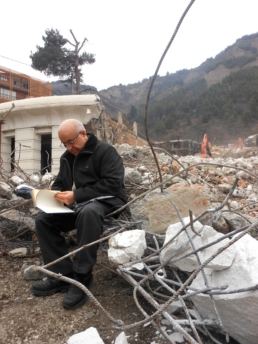
A National Treasure
The demolishment was seen as particularly heedless given that Bostanashvili was well-known and respected among Georgia’s architectural community.
He first rose to prominence during the Soviet era, when he was commissioned to design a number of memorials.
Among them was the Glory to Work monument in Kutaisi, which consisted of three marble rings that shrouded a trio of sculptures that were to be changed every five years. Framing the relationship between the lasting and the transient, it served as an early illustratration of Bostanashvili’s poetic style.
The architect went on to sweep the Soviet Union’s building of the year award in 1987 for his design of the National Bakery in Tbilisi. It was during this time that he began collaborating with the design bureau at the Georgian Polytechnic Institute, engaging in experimental projects.
As the Soviet era came to an end, opportunities for commissions dried up. Bostanashvili took up teaching at the institution full time, which was then renamed the Georgian Technical University.
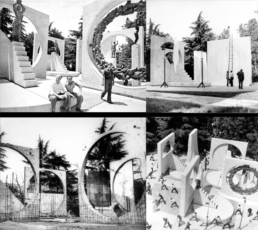
The Poetics of Architecture
In 1990, he founded the ‘Poetics of Architecture’ studio, under which he delivered workshops and lectures. Taking a philosophical approach, Poetics proposes the re-reading of architectural history, through removing temporal and topographical dimensions. By taking away the lens that categorises through time and surface, it aims to organise through artistic synthesis. The forms are named – Mass, Wall, Column, Stair, Frame, and Veil, and organised by a cycle of five narratives: Becoming, Dialogue, Metamorphoses, Paradox, and End.
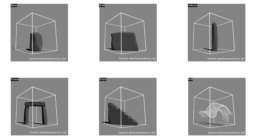
Shota’s son, David, who also went on to lecture in architecture at the Georgian Technical University elaborates: “He introduced a linguistic triad – Image, Name, and House. In Georgian, due to a fortuitous coincidence, these three words sound very similar (sakhe, sakheli, sakhli). It is through these three names that the theory of architecture unfolds within the language. To quote Heidegger: ‘It is language that tells us about the nature of a thing, provided that we respect language’s own nature.’”
Shunning traditional teaching methods, Shota Bostanashvili’s lectures were popular among students for their innovative approach. David elaborates, “While the themes carried heavy philosophical weight, his lectures were more like plays, impersonations, and attempts to engage the students in play rather than dry academic expositions.”
While working as a lecturer, Shota’s yearning to fully-realise his designs did not subside. Yet following the Soviet era, opportunities to do so came few and far between.
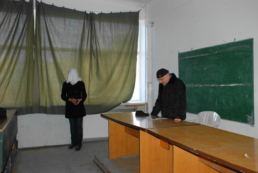
The Palace of Poetry
“After Georgia gained independence, there was a period of turmoil and economic disaster, when there was no practical work,” David explains. Anything to do with experimental design was channeled purely into the academic field. It was by a stroke of luck that Shota was commissioned to create The Palace of Poetry for a private client.
“Initially, the client wanted some kind of entertainment center including restaurants and maybe even a casino,” recalls David. However, as the architectural idea of flower-like towers surfaced, it then dictated the function.
“My father convinced the client to give him the freedom to work on the site and for them to think of the building as a house for poetry and culture.”
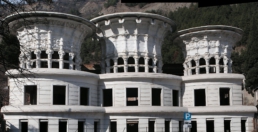
It was named The Palace of Poetry – Artistic Flowers, the latter part being a reference to Georgian poet Galaktion Tabidze’s first collection of poems.
“It was named like this not only because he wanted it to serve as a cultural centre where poetry would be celebrated, but also because the palace was built from poetry (and the poetic vision of the artist himself)”, he explains.
The giant sculptural towers were carved in plaster by Bostanashvil himself with the help of a friend of his who was a sculptor.
The three towers have three different themes, with one featuring humans, another tigers and the other with a ram on its facade. This part of the process took a year alone. The side curvilinear facade was made as a small plaster model and then transferred onto a one-to one scale.
According to David, in the era of technology and the oncoming digital revolution, it was a deliberate statement to make a building using the most basic instrument – the human hands.
In 2003, after four years of work, the building’s exterior was completed, however the client decided to suddenly put the breaks on the project. For a decade, the building stood at the gates of the city half-finished.
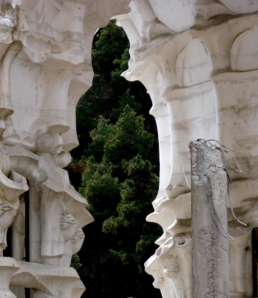
The Toppling of the Towers
After a search online, David and his father found out that the building had come under new ownership, and that they planned to build an upscale apartment block there.
Such developments were particularly common during this period. It was during these years (2008-2013) that the Saakashvili administration had implemented a campaign which aimed to attract foreign investment to Georgia, incentivising through low taxes and ease of regulations.
“Georgia’s economy is dominated by investment capital in developments”, says David.
“The apartment blocks create rentable floor areas and it is a very quick and easy way to make big amounts of money. No proper regulations or documentation for city planning exists. And when there is a document that regulates something, the same document has either deliberate loopholes, or contains direct statements regarding how much it will cost to overstep the regulations.”
In the end, no one was liable for the plans to demolish the building. To top it off, Shota was of ill health, and recovering from heart surgery.
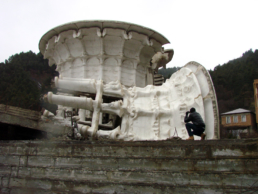
However the demolition wasn’t to go unnoticed. David, alongside a group of Shota’s students, gathered to help organise an action protesting its destruction.
“The Palace of Poetry never opened its doors. So for the building to be inaugurated on the same day of its destruction with the architect reading poetry in front it — well, it was quite inspiring. I think it was a kind of therapy, to grasp some artistic, poetic occasion even in the face of a tragedy (and it was a tragedy for my father)”, David laments on the action.
“Even the sound of the machinery becomes a poetic sound. In a sense, retrospectively, it was as if the building was built for this very moment, for this performance.”
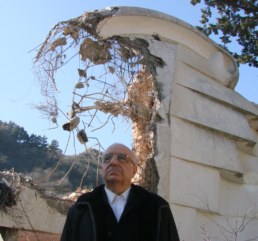
Students were invited to go to the site instead of lectures for a ‘live performance’ that served as a ‘lesson’ in architecture.
“During the first reading he recited his own poem, titled Titled nara/tivi (narrative). Tivi means raft in Georgian. So he plays with the words narrative and raft: “Friends! The pirates took my raft.., my ship, my boat, my vessel, my craft”.
The second reading took place on the last day of winter when the last tower was toppled. The last reading was three days later, when only rubble was left in place of the palace. Aside from his own poetry, he also recited verses from Georgian poets Otar Tchiladze and Galaktion Tabidze.
David, and another student, Shota Jojua, filmed the demolition of the building every day for two weeks. “It was like a full time job, from 9-5, capturing it from two angles.”
“The reason we were there all the time was to capture the moment the towers would fall, but we couldn’t tell which day that specific operation was planned. So we waited and filmed.”
According to David, when they did get around to pulling it down, they couldn’t: “It was too well-built! So they had to postpone it until the next day.”
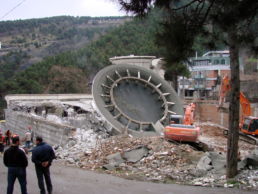
Each reading went behind without incidents, and the workers appeared to show no animosity.
“It was hard to handle emotionally, as I knew how much it meant on one hand, and felt kind of guilty by not being able to help in any way. But as I said, this process of filming was a kind of therapy. It kept us busy.”
The film was released as part of David’s project Flowers of Stone which documents the building’s destruction.
Later that year, Shota Bostanashvili died unexpectedly whilst delivering a talk at a conference dedicated to the Georgian poet Otar Chiladze.

Drawing the line
David believes that there must be fundamental, albeit democratic changes to prevent such things from occurring in the future. “I think before there is a law, first there must be a consensus in society where we draw the line for developers, and also a discussion about what architecture and Soviet heritage signifies for us.”
He underlines that there are currently no mechanisms in place to curb the reckless behaviour of real estate speculators. “Even if a building is listed as national heritage, the status can be removed easily, like what happened with the Imeli building – Alexey Shchusev’s masterpiece.”
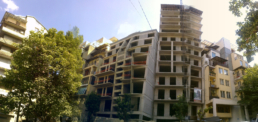
With major airlines launching direct routes to Georgia from Europe, the country has witnessed a boom in tourism in recent years. This growth has birthed new tours that veer beyond the traditional circuit, focusing on Georgia’s Soviet past, as well as its socialist architecture.
For David, this could be promising, “I believe this recent appreciation of socialist architecture from our international colleagues and public will play a significant role to bring the matter to the attention of decision makers and investors”.
“What we need is cooperation between government bodies, NGOs, architecture researchers and investors”.
Perhaps if this is established, then there’s little reason why regulations can’t either.